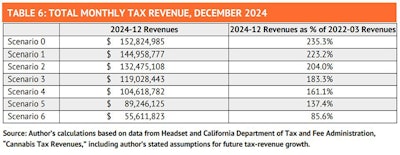
A new study on California’s cannabis tax structure and low participation in the state’s legal market suggests that lawmakers should consider repealing or suspending the cultivation tax—a revenue stream that grossed more than $163 million in 2021.
The six-part study was published May 4 in a 42-page report by Los Angeles-based Reason Foundation, a nonprofit libertarian think tank. It provides an empirical model to estimate the degree to which California’s tax regime affects participation within its commercial cannabis market.
One key finding was that keeping the state’s current tax structure would generate slightly more revenue than reducing tax rates, based on market growth projections for December 2024. However, eliminating the cultivation tax would bolster enough market growth to yield similar revenue results over the same time period (see full details below).
The study also provides further insights on California’s various tax structures and examines consumer decisions to participate in the legal or illegal market in an effort to quantify the impact of taxes on participation.
“Taxes affect both consumers’ and producers’ decisions in the legal market primarily by introducing a price disparity between legal cannabis products and comparable cannabis products offered through the illicit market,” wrote Geoffrey Lawrence, the foundation’s managing director of drug policy, who authored the report.
“Similarly, local bans on legal sales over extended geographic areas can drive consumers without access to legal products within a reasonable distance of their homes to purchase substitute goods on the illicit market,” he added.
The Bottom Line
In the conclusion of the report, Lawrence suggested that wholesale cannabis taxes are hidden from the ultimate consumer, and are difficult to administer, audit and “pyramid” up the supply chain. He added that the Reason Foundation’s analysis makes clear that repealing California’s cultivation tax will result in faster growth of the legal market and will “quickly” result in more total tax revenue than the state receives currently.
According to the analysis, California’s total monthly revenue would grow to roughly $145 million by December 2024—a 223.2% increase from March 2022—should the state eliminate its wholesale cultivation tax and retain its current cannabis retail excise tax rate of 15% and statewide general sales tax rate of 7.25%. That calculation was based on data from Headset and the California Department of Tax and Fee Administration (CDTFA).
If California makes no changes to its current cannabis tax policies, the Reason Foundation projects total monthly revenue would grow even more, to roughly $152.8 million by December 2024—a 235.3% increase from March 2022.
While making no changes still yields the highest amount of tax revenue, eliminating the cultivation tax would result in only a 5.15% reduction in revenue by December 2024, all while encouraging greater participation in the legal market, according to the analysis.
The study also provides revenue projections based on both eliminating the cultivation tax and lowering the state’s excise tax to 12.5%, 10%, 7.5%, 5% and 0%.
“As reductions in the cultivation and retail excise taxes drive overall market growth, revenues realized from the general sales tax grow in both proportional and absolute terms, partially offsetting revenue loss from the tax reductions,” Lawrence wrote.

The Significance
In a forward commentary to the report, California NORML Director Dale Gieringer, Ph.D., wrote that reducing the illicit market is a key element in restructuring the state’s cannabis tax system.
“In the end, [the study] projects that even with substantial tax reductions, the state can expect total revenues to rise substantially in the next two years due to increased consumer demand,” he wrote. “Substantive tax cuts therefore seem to be a feasible strategy for reducing demand for the illicit market while still retaining reasonable revenues for the state programs funded in Prop. 64.”
For many operators playing by the rules in California’s cannabis industry, the state’s cultivation tax makes no sense.
In addition to the 7.25% sales tax and 15% excise tax, California levies its current cultivation tax rate of $10.08 per dry-weight ounce of flower, $3 per dry-weight ounce of leaves and $1.41 per fresh cannabis plant ounce.
“It’s weight-based, which means it goes up as a percentage as prices compress, and [it] hits outdoor farmers the hardest,” Santa Barbara-based Glass House Brands co-founder and president Graham Farrar told Cannabis Business Times in January.
For instance, if a greenhouse grower endures a $160 cultivation tax for a pound of cannabis that wholesales at $1,000 per pound, and an outdoor grower endures the same $160 cultivation tax for a pound of cannabis that wholesales at $500 per pound, then the tax burden would be 16% for the greenhouse grower and 32% for the outdoor grower.

Under California’s current tax structure and an insufficient number of licensed retailers, among other factors, the Reason Foundation’s report estimates that the illicit market accounts for roughly two-thirds of total sales in the state.
How California Ended Up Here
Under 2016’s voter-approved Proposition 64, an ambitious package of cultivation and excise taxes were imposed with the aim of raising more than $1 billion a year for various state programs. That effort succeeded soon after the state’s 2018 adult-use retail launch.
Adult-use cannabis wholesalers and retailers generated more than $1.1 billion in total state taxes in 2020 and nearly $1.3 billion in 2021, according to CDTFA data.
On top of that, local governments were authorized to levy more taxes on their own.
But, as Gieringer pointed out in his commentary, municipalities were given the authority to prohibit cannabis operations altogether through Prop. 64 and the Legislature’s subsequent Medicinal and Adult-Use Cannabis Regulation and Safety Act (MAUCRSA), which established a parallel licensing system for both medical and adult-use cannabis.
“The situation was further exacerbated by local dispensary bans and licensing delays, which left the state with half as many adult-use dispensaries as there were medical collectives before Prop. 64 was passed,” Gieringer wrote. “As a result, California’s legal industry has been hard-pressed to compete with untaxed, unregulated providers on the underground market. So dire is the current situation that advocates now fear that the cannabis industry in California faces an ‘existential crisis’ in the absence of meaningful tax reform.”
RELATED: ‘Surviving is Thriving’ in California’s Cannabis Market

California Department of Tax and Fee Administration | cdtfa.ca.gov
Legislative Effort
While the Reason Foundation’s report recommends repealing or suspending the cultivation tax, California lawmakers are already proposing that policy shift.
Last week, the state’s Senate Governance and Finance Committee members voted, 4-1, to advance Senate Bill 1281, which aims to repeal the cultivation tax and reduce the state’s excise tax rate to 5%.
“While [Prop. 64’s] implementation is still in its early years, the industry is overregulated and overtaxed, putting the legal cannabis industry on the brink of collapse,” Bradford said in the analysis of his bill before the committee.
“Cannabis operators report that without meaningful change, the industry is destined to failure,” he said. “S.B. 1281 would eliminate the cultivation tax and reduce the excise tax as they undermine the viability and sustainability of California’s cannabis industry.”
Bradford added that while eliminating the cultivation tax and reducing the excise may decrease overall tax revenue, it’s anticipated that greater demand and increased sales of a more competitively priced cannabis product will offset lost revenues.
According to the Reason Foundation, repealing the cultivation tax and lowering the excise tax to 5% would result in roughly $89.2 million in total monthly tax revenue by December 2024—a 137.4% increase from March 2022.
Bradford’s legislation was referred to the Senate Appropriations Committee, where it’s scheduled for a May 16 hearing.
More Hope on the Horizon
Despite the retail shortage since Prop. 64, California’s Department of Cannabis Control (DCC), which was established on July 12, 2021, by consolidating three former state cannabis authorities, has made recent advances in licensing cannabis retail operators.
In less than a year, DCC has increased California’s active retail footprint by 20.3%, including an additional 140 storefront dispensaries, 91 retail delivery licensees and 38 microbusinesses with retail activity, according to department’s licensing data from May 9.
In March alone, DCC officials issued 31 dispensary, 22 delivery and seven microbusiness licenses—the department’s highest monthly volume to date, DCC Deputy Director of Public Affairs Maria Luisa Cesar told Cannabis Business Times.
“We are proud of our efforts to streamline cannabis licensing regulations by combining them into one rulemaking package,” she said. “This has allowed prospective applicants, pending applicants, and licensees one regulatory framework to review and follow. Within the Licensing Division at the department, staff have aligned internal review processes to ensure that applications, license renewals and license modifications are moving more efficiently.”
Also, DCC officials announced in January that the department had awarded nearly $100 million in grant funding for local jurisdictions to aid in more swiftly transitioning high numbers of provisional cannabis licenses into annual licenses.
Overall, California now has 948 active dispensaries, 427 delivery retailers and 218 microbusinesses. The DCC issued 190 of those licenses, or 12% of the active total, in the first four months of this year.

Buckling Up For Long-Term Growth
Amidst the recent advances, the state’s retail footprint still has a long way to go, according to Hirsh Jain, who serves on the board of Los Angeles NORML and the Los Angeles Cannabis Chamber of Commerce.
The 100 storefront dispensary licenses issued in the first four months of 2022 surpassed the 96 dispensary licenses issued in all of 2020, Jain pointed out on social media last month.
Nevertheless, California’s licensed retail industry will take years to get to where it needs to be without drastic change, he said.
“[California needs a minimum of] 4,000 dispensaries to serve the legal market,” Jain said. “Despite recent positive trends, CA’s retail infrastructure will remain lacking for years, creating challenges for operators across the supply chain. Many won’t be able to survive in this harsh operating environment.”
What the Numbers Say
Specifically, California’s 948 licensed brick-and-mortar cannabis retailers equates to roughly 2.4 dispensaries per 100,000 residents, much fewer than Pacific Coast neighbor Oregon’s roughly 18.3 dispensaries per 100,000 residents. Although, Oregon recently enacted a licensing moratorium in response to a crowded marketplace.
Should California increase its footprint to 4,000 dispensaries, as Jain suggested, its retail rate would increase to roughly 10.2 dispensaries per 100,000 residents.
But that retail growth would depend heavily on a tax structure that attracts more potential operators into the licensed marketplace in addition to more consumers transitioning to the legal marketplace.
In 2016, California’s Legislative Analyst’s Office (LAO), a nonpartisan government agency, projected that providing legal status would result in more efficient production and lower risk premiums demanded by suppliers, which would lower the cost of production and bestow a price advantage on legal retailers, thus, driving consumers toward legal products, according to the Reason Foundation’s report.
“It is clear that the LAO’s anticipated price advantages have not materialized, and many consumers have failed to transition toward legal retailers,” Lawrence wrote. “Existing tax structures and rates may be a key reason why.”
























